Tips On Storing Food Storage Safely
Today, I want to share my tips on storing food safely. I’m very concerned with what I see on Facebook and many blogs concerning food safety. Here’s the deal: We can’t afford to waste our precious dollars on the goods we buy to feed our family if we can’t store them properly.
You may have a different opinion, and I respect that. I have been canning food for over 50 years, and even so, Mark and I went several years ago to get our Master Canning Preserver Certificates.
Things change, and canning has had to change because food grown now is less acidic. Therefore, we have to adjust our canning habits. If you missed this post, please read it: Four Things That Are Not Safe To Can At Home.
My tips are easy to follow and will save you money in the long run. You have probably heard me say, “Buy right the first time.” To help you understand and deal with the necessary changes, I will walk you through my journey of storing food, and I’ve been doing it for 56 years.
I have been married for 56 years and have always had food storage. Some years were leaner than others, but I have always had food.
My mother taught me to make bread and to cook from scratch. Those are two valuable skills, and I appreciate the sewing skill that she taught me. If you have taught your family these skills and more, I applaud you. I do because you have taught them to be self-reliant.
Today I’m only talking about food, not water. You know my thoughts on storing water, please store at least 4 gallons per person daily. You may think that is way too much. It’s not, trust me on that one.
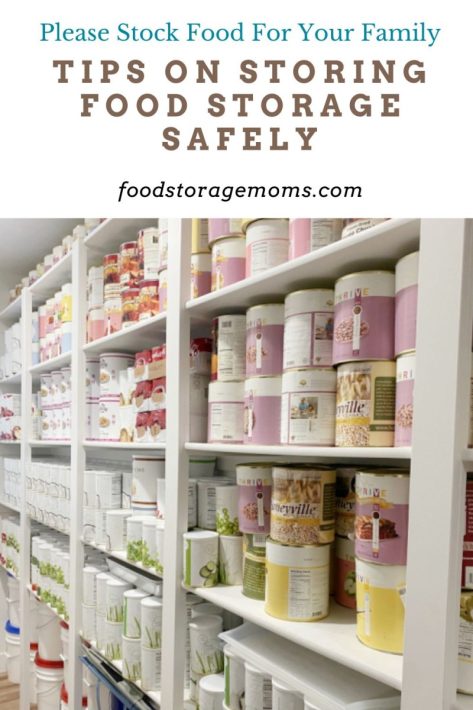
Tips On Storing Food Storage Safely
Shelving
When Mark and I were first married, we built some shelves ourselves. We were newbies, but we knew we needed to store food. We bought brackets, metal strips, and shelving.
Then, in our next home, we built shelves attached to the two-by-four studs in the basement. Those were perfect because I could see all the jars lined up that we had bottled. They were super strong and held up very well.
Fast-forward to now, and we have downsized to a much smaller home in Southern Utah. This house was perfect for the two of us and our two puppies. We even had room for guests. Thankfully, our family didn’t mind sleeping with buckets of wheat in the guest bedroom.
To stock our #10 cans, we purchased shelving from Costco online. The shelves in the store are not as sturdy. These are the ones I bought (then I added plastic sheets on the shelves) at Costco: Trinity 6-Tier Wire Shelving with Wheels.
We had wheels so we could move them easily if necessary. Those are 4-foot Bungee cords from Home Depot holding my cans in case of an earthquake.
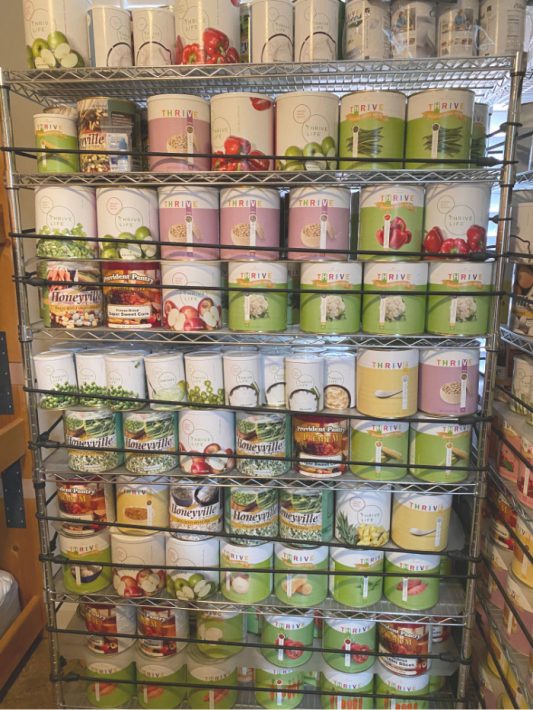
Updated: Our Home in Northern Utah
As you know, we have moved up north to be closer to family and friends. We now have a home that is 1000 square feet. This was trickier to store our food storage and emergency preps. I have had to let go of some things because of my oxygen issues.
We had custom shelves built to accommodate most of our food storage. They were supposed to be 2 feet deep, but the builder didn’t hear that somewhere along the line, so it is what it is.
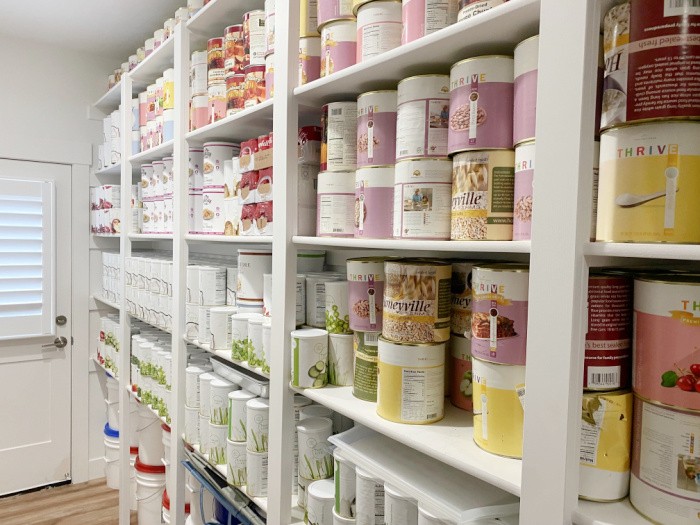
Buckets/Gamma Lids
This is how I store my Lehi Mills hard white wheat. I only buy wheat from them because they clean it at least six times, whereas most companies only clean their wheat two times.
My wheat grinders are pricey, so I can’t risk running cheap wheat through them. These Lehi Mills buckets are 6-gallon in size.
I store all my white bread flour and wheat with Red Gamma Lids. Everything in my house is color-coded.
I admit I may be a perfectionist—yep, I own it. I don’t put oxygen absorbers in my wheat and never use Mylar bags. I also don’t live where it is humid.
The wheat comes in these buckets, and I replace some lids with Red Gamma Lids. I pour the newer wheat into the buckets with the Red Lids, which is how I keep track of the freshest wheat.
Wheat-Hard White Wheat
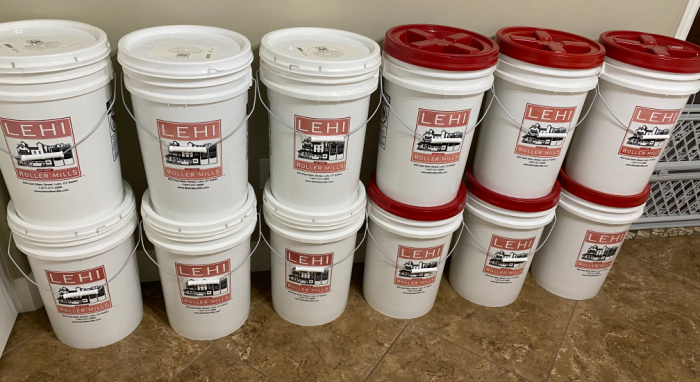
Containers
I love to buy Rubbermaid 8-quart and 12-quart commercial containers, like the ones below. They are airtight, and the lids are easy to remove and put back on. I use them because we used to live in the desert, and we had critters.
Yes, I have bug spray monthly; I have to. But I only spray the perimeter of my house. Mark and I can sleep at night knowing our food is protected from pests outside.
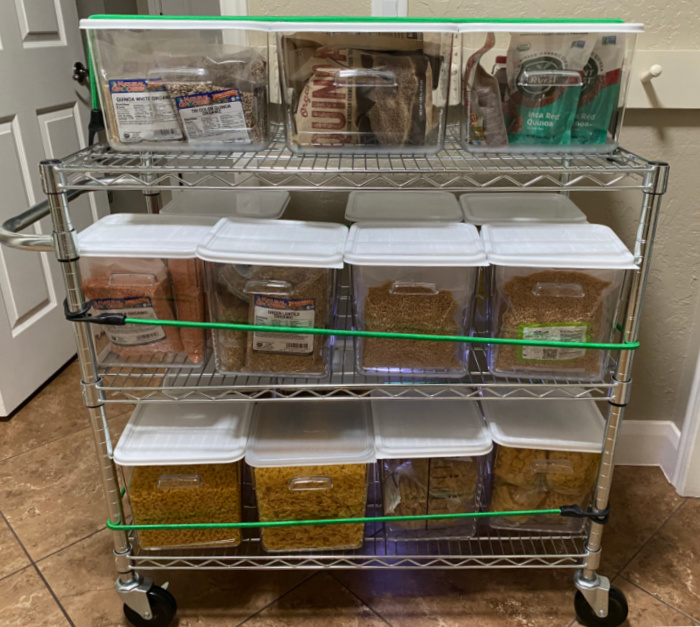
Canning Jars
These are mason jars made by Ball and Kerr. It’s been an easier year to get canning supplies, including lids, water bath canners, and pressure canners. Please note: Be careful what you read on the internet.
It is not SAFE to oven-can any food. The jars are not designed to have DRY HEAT, they may EXPLODE. In case you missed this post, Four Things That Are Not Safe To Can At Home
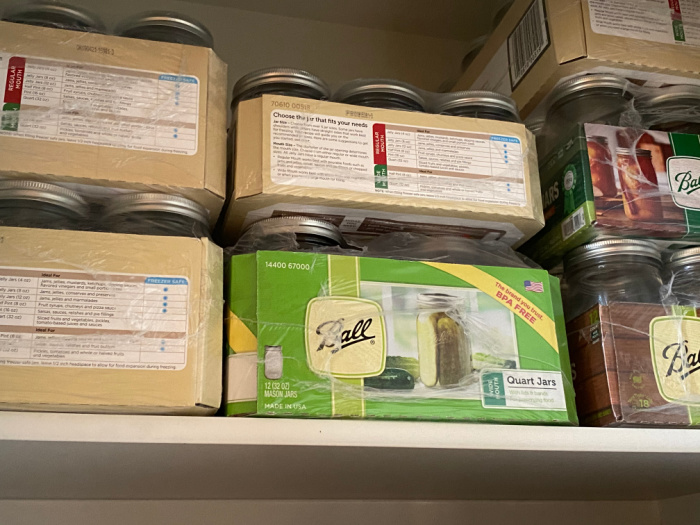
FoodSaver
FoodSavers are fantastic for food storage. I don’t use oxygen absorbers when I place food in my mason jars when using the FoodSaver Jar Sealer. I did call FoodSaver, and they said the old-style accessory hose is going away. It only works with the V2000 or V3000 series. The new accessory hose is now green and black, which is why people were having trouble getting the old style hose. The picture below shows what the old style looks like. Now we can use the Dicorain! Thanks to Ray for telling us about it.
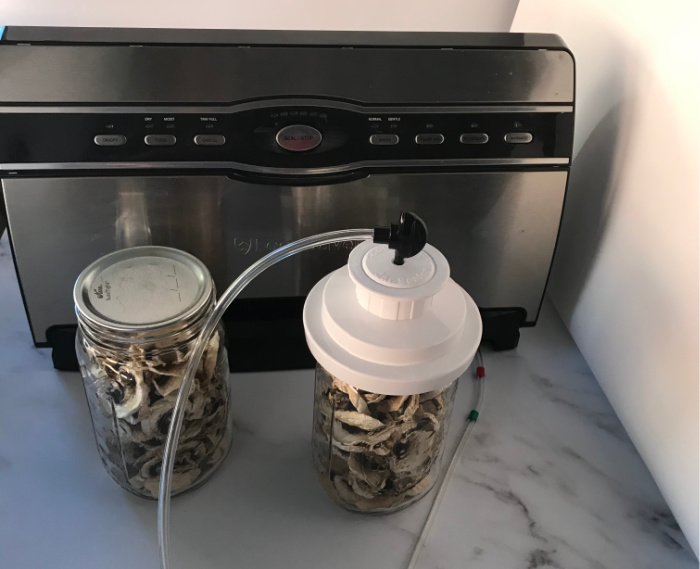
Now we can use the Dicorain! Thanks to Ray for telling us about it.
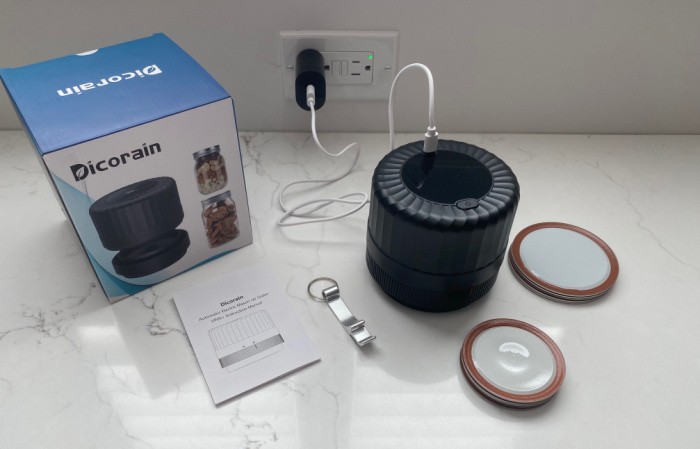
Long-Term Food Storage
My suggestion to all is to start with small cans of food, and when you have extra money, buy some commercially processed Freeze-Dried food in #10 cans with a shelf-life of at least 25 years stored inside your home.
Please buy one #10 can a month. Since the prices have skyrocketed this year, I advise waiting until they are not so high to continue your long-term food storage efforts. Here is a post you should read: Canned Foods I Highly Recommend You Store (these are short-term). Another option is to sign up for their newsletters and watch for discounts.
Dehydrating Food
Having a dehydrator is awesome for dehydrating your food. Mark and I took classes to get our USDA Master Canning and Preserving Certificate. We have both been canning together for 56 years or so.
But I wanted to know if there were changes in the canning world. Yes, indeed, there are changes. Our food has changed. It’s less acidic, so we have to make a few changes to our old canning ways.
We learned in class that the food we water bath, pressure can, or dehydrate ourselves has a shelf-life of one year. Yes, I have eaten some home-canned peaches that are 2-3 years old.
I get it. But it’s best if used within one year. So there you have it.
I have an Excalibur Dehydrator, but I have friends who have a Nesco and love theirs. Please get one that fits your budget. You will never waste food again. You can dehydrate leftover fruits and vegetables for snacks or soups.
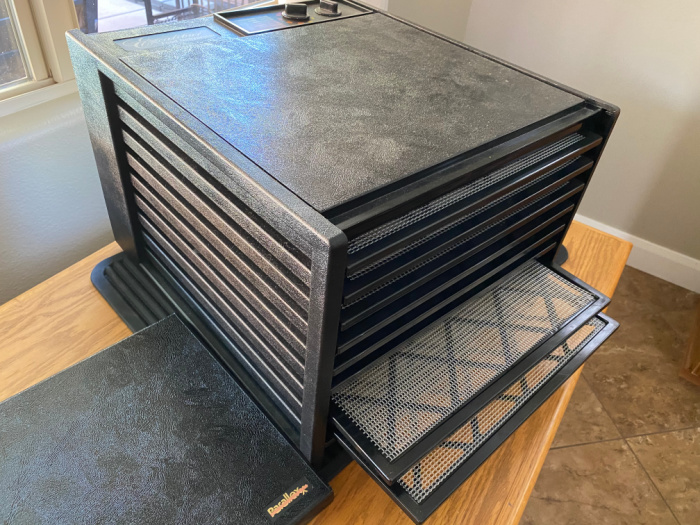
Food Storage Types
Freeze-Dried Food:
Let me explain freeze-dried food in a nutshell. The first step is freezing, followed by placing the frozen food in a vacuum chamber under low heat.
The third step starts when the frozen water crystals evaporate directly from ice to vapor, a process called sublimation.
What’s nice about freeze-dried food is that, depending on the manufacturer, it generally lasts longer in your storage stash. Please always look at the cans and see the shelf life listed.
You can eat the food directly out of the can, so meal preparation uses much less fuel. Freeze-dried foods usually have an open shelf life of 1-2 years.
Again, please look at the #10 can or the manufacturing company’s website for details.
Pros: You can eat it right out of the can. It uses less fuel because we can get by on most foods without cooking them. The bonus is that it has a longer shelf life than dehydrated food.
Cons: It’s more expensive.
Dehydrated Food:
Okay, most of us purchase dehydrated food every day. We buy cereal, spices, pasta, beans, baking mixes, etc. Dehydration is the process of removing water from the products.
The water is slowly removed from the food without actually cooking it. This is one of the most affordable, lightweight, and compact ways to purchase food for storage or everyday cooking.
We need to be aware of the term “dehydrated.” It generally takes longer to cook. Most items can’t just be “eaten” right out of the can—they’re too hard. This is fine for soups, stews, etc.
We must remember that dehydrated food does not typically last as long as freeze-dried food. Dehydrated food usually has a 5-8 year shelf life, while freeze-dried food usually has an OPEN shelf life of 6 months to 1 year. Please read the information provided by the companies you purchase from or produce the food.
Pros: It costs a lot less money.
Cons: It uses fuel to cook it and has a much shorter shelf life.
Mylar Bags/Oxygen Absorbers
I must set the record straight about not using Mylar bags and oxygen absorbers. About 12 years ago, I dry-canned food from a local church cannery in Salt Lake City, Utah, in #10 cans. Mark and I purchased the food there and were handed Oxygen absorbers. It was the first and last time I ever did this.
My daughter came, and we were all working together. Our mistake was that the volunteers at the cannery had zero experience using oxygen absorbers.
We dry-canned beans (full of large, inferior-quality rocks), dehydrated onions, carrots, and celery, and were so excited to be getting the food cheaper than, say, a commercial company.
Our problem was that the oxygen absorbers were open, warm, and used, so they would not work.
We were newbies and had no idea what we were doing. One year later, my daughter called and said, “Mom, I think these carrots are rancid.” So I opened my cans, one after another.
Yes, indeed, we wasted $1,200.00 on food we had planned to use for our entire family to have some food storage. All of the food had to be trashed.
At the time, I was teaching classes at Honeyville Grain in Salt Lake City, Utah. The company offered free courses to show people how to cook with food storage, and many outstanding teachers came and shared their expertise.
On one of the days I was teaching, an expert on oxygen absorbers was also teaching. What I learned that day changed my view forever on oxygen absorbers and Mylar bags.
There is a margin of error that can’t be missed when combining ounces of food with the different sizes of oxygen absorber cc’s. You don’t just throw an oxygen absorber into a Mylar bag or #10 can without first calculating the exact number (or more to be safe) of cc’s per ounce for the TYPE of food you put into #10 cans or Mylar bags.
MISTAKES can and will be made. This means different foods use different cc’s. Please be careful, or you may become sick from your processed food.
Storing Food Long Term
- How to Store Butter Long Term
- How to Store Cooking Oil Long-term
- How to Store Salt Long-Term & 9 Rational Reasons You Should
- Popcorn for Food Storage
Final Word
I hope you enjoyed today’s post on how to store food safely. We must stock food to keep our families safe. My gut tells me that there are still families out there that are not doing what they should be for one reason or another.
Do they love standing in line at the city and county buildings to get food after a disaster? Maybe they think the government will deliver food to their homes after a major disaster, I don’t know.
I have heard from local church leaders in my Southern Utah area that less than 10% of people are prepared to take care of their families after a disaster. Some leaders have asked me to come and teach some of the mothers in their congregation how to cook.
It was hard for me to say no because I love helping others. But I was surprised that in a congregation of 350-500, no one was close by to teach others to cook from scratch.
One leader sent me an email and asked, “How do I light the fire under these families in her church so they’ll be better prepared?” Wow, all I can say is, wow.
I feel like shouting from my rooftop, “People, get your act together!” Of course, I know several families in each area will be able to take care of themselves. At least I hope so. May God bless this world, Linda
Copyright Images: Various Fruits and Vegetables that have been Canned at Home AdobeStock_211841782 By Pamela_D_Mcadams

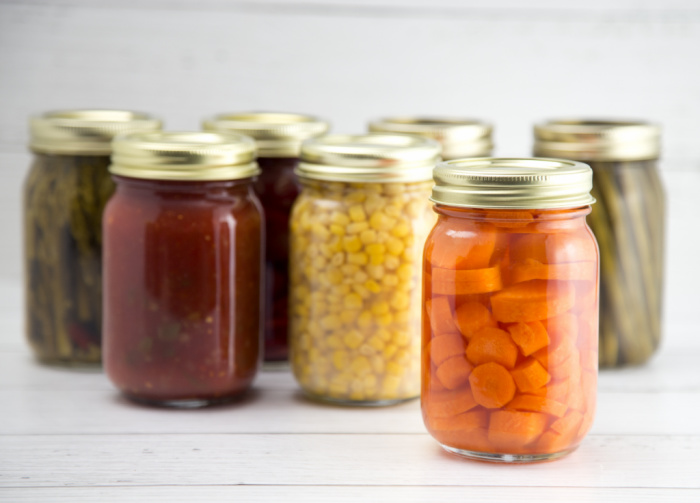



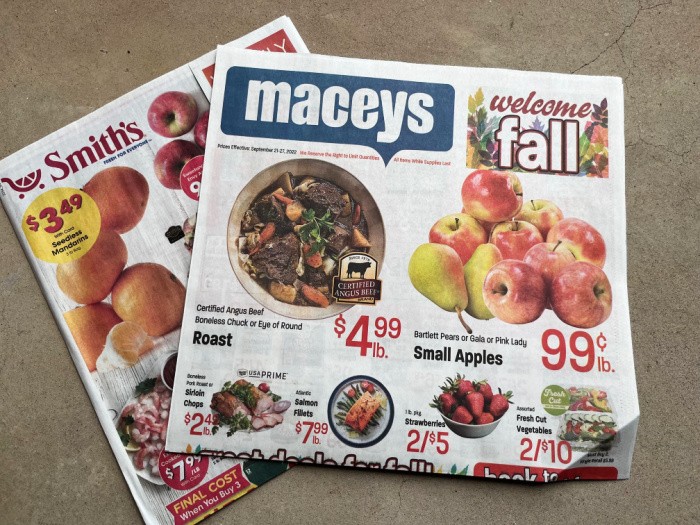
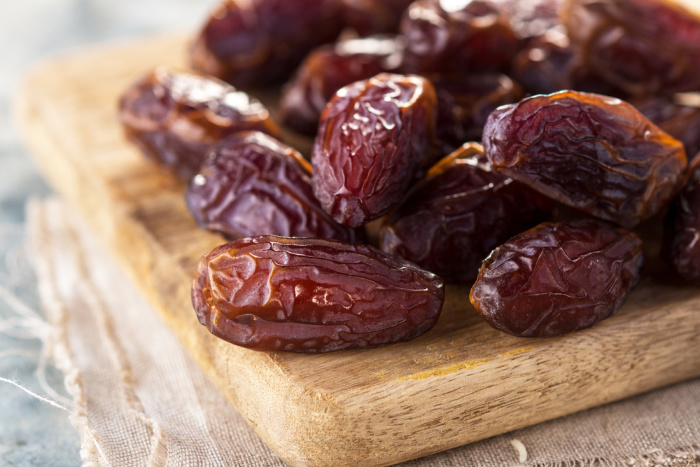
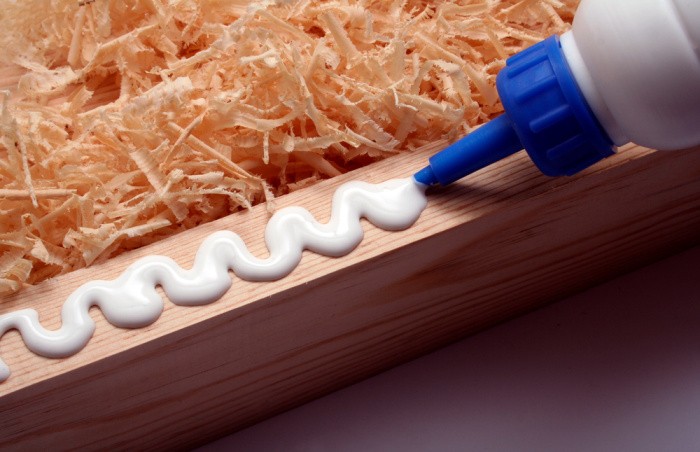
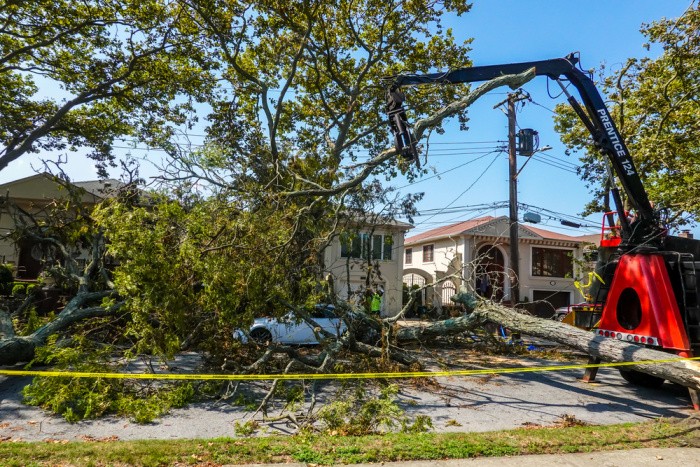

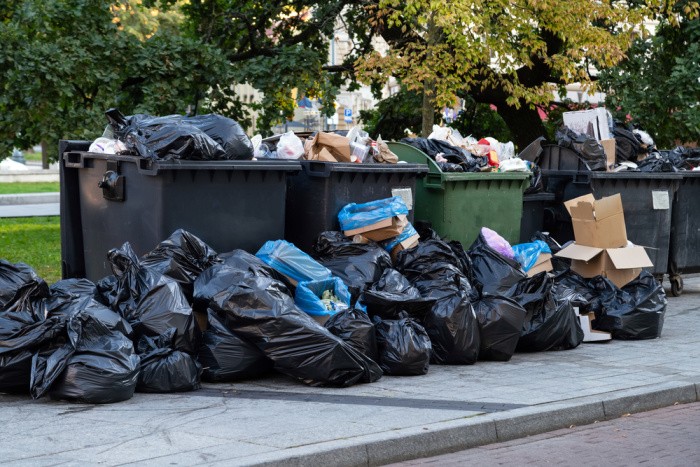
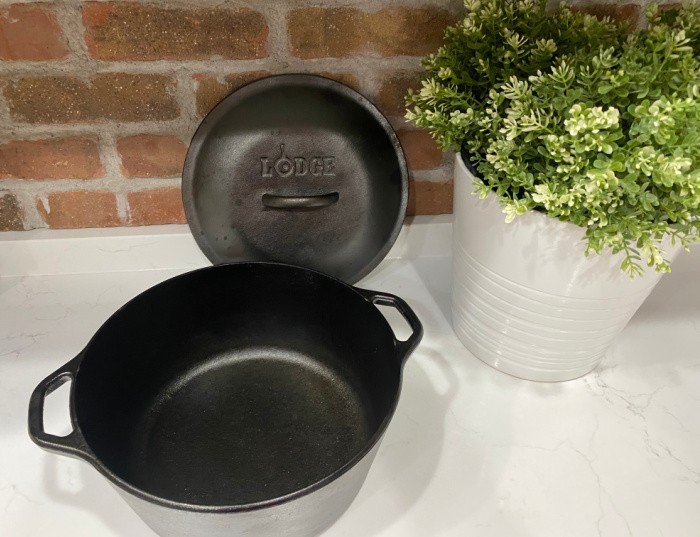
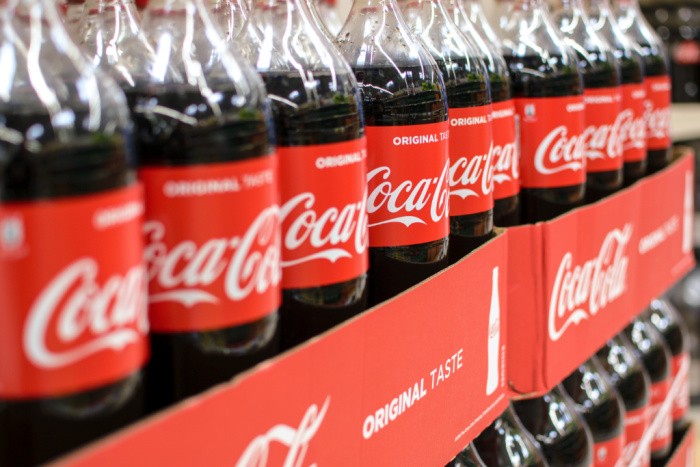

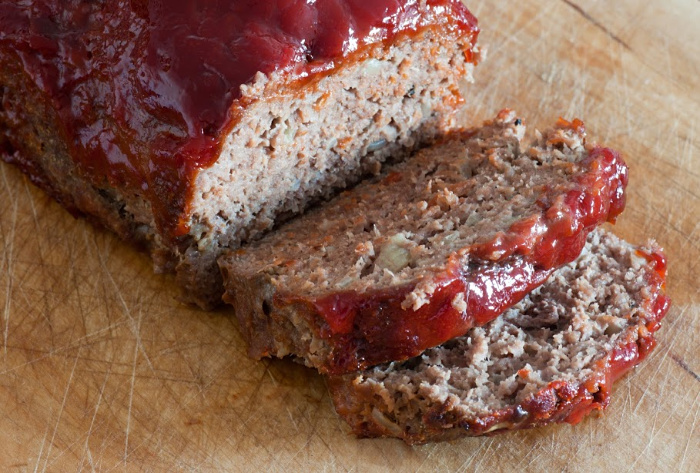
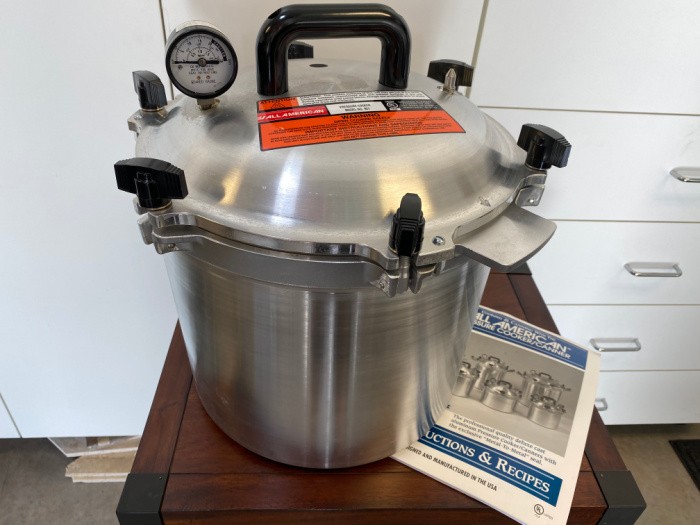
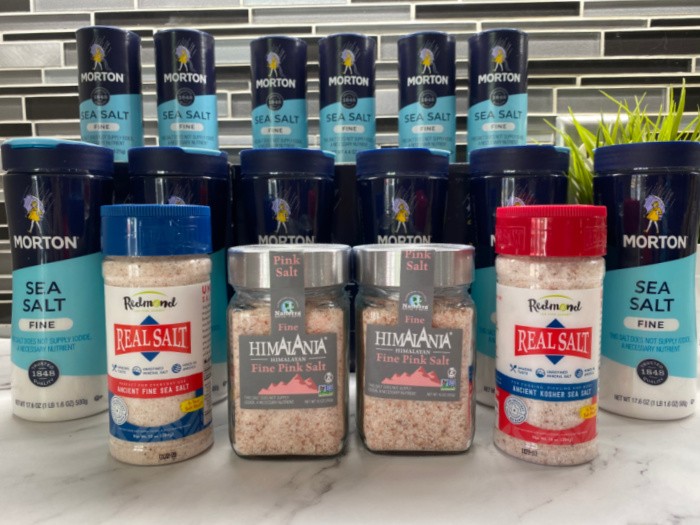
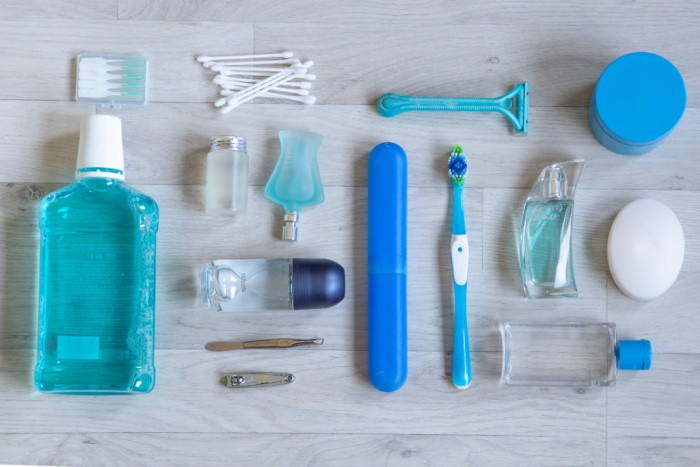
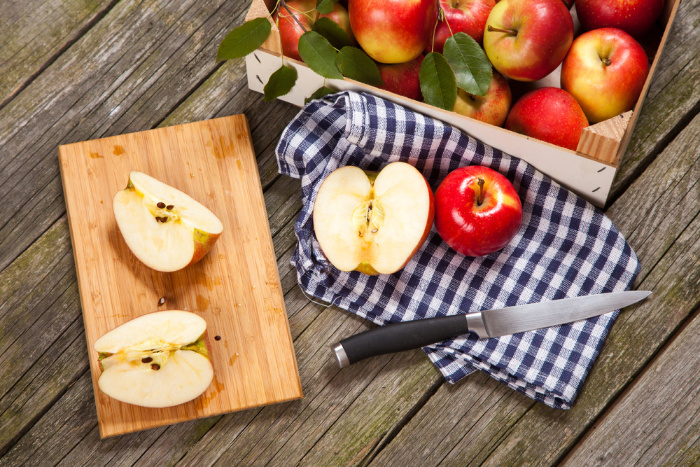
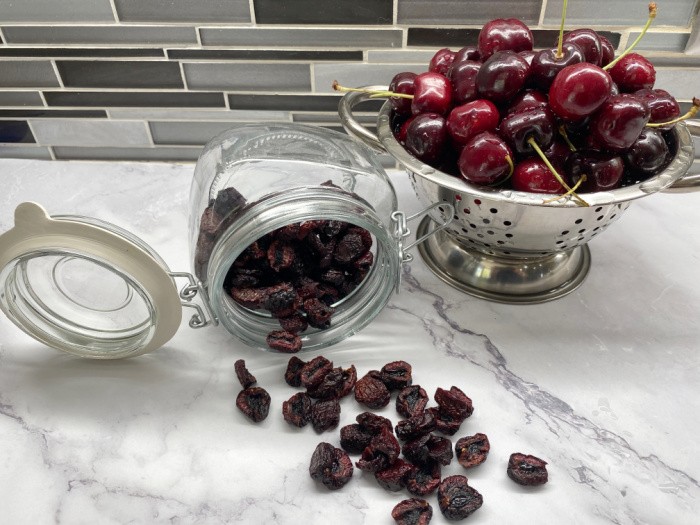


I spent 6 yrs of my army career being responsible for the “water buffalo” the tank we used to haul water to the field for training. It was 300gls and we had 100-120 people. I filled it every day to every day and a half.
The1gl per person per day recommendation is just to sit at home, do nothing and stay alive. The minute you add labor, laundry, dishes, toilet flush and hygiene it increases.
I wish I was organized as you with my food storage. That looks awesome. I’d love to have that dedicated room. I’ve got what I refer to as the “closets of life” (food/medical) and the “closets of death” (guns/ammo).
I’ve certainly made my share of mistakes as well in preparations. I do use Mylar and occasionally O2 absorbers but only in certain items.
Yesterday I bought 50lbs of non iodized salt for fresh meat storage post SHTF and I won’t use O2 absorbers on it because it makes the salt brick up and I need it loose to cover the meat. I will Mylar it in 3-4lb bags and bucket it for convenience and storage.
Make sure you mark the bags and the buckets with sharpie on contents, date etc. Cut out the nutrition and cooking data and add it to the bucket when you store it too. Though I might know it all it might be one of my grandkids that uses it and they might not.
Do what you can with what you have.
Stay safe.
Hi Matt, I do not have a designated room for food storage. LOL! I put those rolling carts in a bedroom where I have two sets of triple bunk beds for the grandkids! Now the grandkids are getting too BIG for bunk beds, but we still use them when we have visitors. I roll the carts out so they can sleep. It’s not a perfect set up but I have a small home and I need food storage, water storage, and beds, lots of beds! I have 17 grandkids. They don’t all come at the same time. I had to pull so much stuff out just to take pictures. LOL! It’s all good. I’m glad to hear you only use Mylar bags occasionally. My concern is for the people that think if they use Mylar bags say for pancake mix or flour it will extend the shelf-life to 25 years. It won’t. I hope they have a lot of Imodium on hand. That’s awesome about the 50 pounds of salt. You teach me so much, thanks Matt! Linda
Wow 17?
I’m exhausted with keeping my 3 lol
Hi Matt, 3 is a great number! A divorce brought us 3 extra ones. We had 14 and we always add the 3 that joined our family through marriage after a divorce. Life is good! Linda
This is one of the best posts! Thank you so much for sharing. I have never used Mylar bags nor oxygen absorbers. Never even seen them. LOL I do have some #10 cans from Honeyville! Great products.
Linda, you have me beat on the grand babies. I only have 11, but . . . I do have 3 great grand sons.
This is an awesome post. I have a question on vacuum sealing jars. Do you kNow how long vacuum canned pecans will last? Or would it be better to freeze them? I have vacuum sealed flour in jars. The secret I found is to use a coffee filter with dry items like flour. I love my vacuum sealer! I also have an old Seal-a-meal sealer. LOL it doesn’t vacuum, but I have used it for other no perishable items. It’s really good for making small bags out of zipper seal bags. I’ve needed some smaller ones for travel.
Hi Deborah, life with grandkids is the best ever! I always freeze my nuts, any kind because they go rancid so quickly. I put my nuts in FoodSaver bags for the freezer. Oh my gosh, I had a Seal A Meal! Boy, that brings back memories! I had it for years until FoodSaver asked me to do a review so they sent me the one shown in this post. I called FoodSaver to ask why the accessory hose and jar sealers are in short supply. They are discontinuing the accessory hose like I have. The new accessory hoses are black and green. Linda
I have two food savers! Love them so much. I also have some bag rolls on hand. I will reuse the ones that hold things that aren’t meat. They are washed and dried first. I will only use the ones with meat IF I put the meat in a zipper bag first. And they don’t leak.
Hi Deborah, I love it! I gave my old one to a daughter. FoodSavers are awesome! Linda
My prepper daughter got one before I did. She got me started on prepping and has taught me quite a bit. Granted, you have taught me much more. I’m of the opinion that you never know it all. I maybe be old, but I’m not too old to learn! I’ll be too old to learn when I’m 6- feet under. LOL hopefully a few more years from now.
I really love putting food up, and learning. I finally found a biscuit recipe that works for me. Equal amounts of self rising flour and whipping cream. So so yummy. Hubby has already asked for them again. They taste a lot like what my grandma used to make, but not quite. I’ll tweak it till they do. But, hers were completely from scratch.
Dear Linda I love your posts and all the work you do. I learn so much from you and your followers. I have a question I could use some advice on. Through some circumstances a few years ago I lost my home and even in it. That means all my stored food. Everything. I have struggled but am back on my feet more or less. I am in a small apartment on social security, so my budget is super tight. Where should I start? I mean from scratch. No jars, no buckets, no shelves, no canner. I mean scratch. And everything now is expensive this time around compared to before, if you can find them at all. Where do I start? I really need advice. Sorry for being so long winded. I need help.
Hi Kathleen, you are never too long-winded for me. Here’s the deal you are not alone, so let’s talk about this. I have changed my views on food storage in the last few years. I’m grateful I had purchased the #10 cans when I did. But, now the prices are so out of control (the#10 cans). Who can afford those? Good grief. Scrap the #10 cans, for now, my friend. I want you to think about what you eat every day. Start with breakfast, then lunch, then dinner. Mark and I are going to give up meat, I refuse to pay those prices. I am taking B12 complex vitamins to compensate for zero meat. You do not need meat to be healthy. Vegetables are so good for you. I cannot afford fresh vegetables in the winter, so in the fall I buy case lot sales of green beans and canned corn. Let me snag a sheet I used to use when I would teach people how to start stocking up. You do not need jars, you do not need a canner. Stack your food in boxes get them from the grocery store. I want you to read this post. It has a printable, if you do not have a printer I will mail you a copy. https://www.foodstoragemoms.com/food-storage-list-printable/ We need to talk, you can get through this. Please email at foodstoragemoms@yahoo.com I am here to help you. Linda
Kathleen ~
If Linda has a problem with being long winded, she would cut me off the list of subscribers!!!
When I started prepping, I started by making up a 1 week menu plan of breakfast, lunch, dinner ans snacks. Then I purchased everything I needed for those meals. This is what my family ate that week. During the week, I made up a 2nd week of menus and purchased everything for that week plus extras of the non-perishables. Of course, I also was working with 2 incomes at the time! I continued to do this until I had 1 month of food stored in addition to what we were eating. I continued this until …
Now, I am single – husband is deceased and daughter grown/married with kids. I have a prepper mindset now and when I shop, if pasta is on sale, I purchase as much as my budget allows – same with any other non-perishable that I eat (canned/boxed). I calculated just the other day that I have 6-8 months worth of non-perishables on the shelf and I feel confident that I can/will survive. I do have some freeze dried foods that I purchased a few years ago (before retirement) but can no longer afford to invest in this manner.
My theory is this: store what you eat and eat what you store. This way, all the non-perishables are in constant rotation.
Leanne thank you so much for your kindness in taking time to reach out to me and encourage me. I truly appreciate your insight and information. I am sitting down today to start a list and a plan. Since I any get paid monthly I have plenty of time to inventory what I have and draw up an accurate budget accordingly to what I can actually depend on coming in. Both you and Linda have given me a lot to think about and work with. God bless.
Great comment Leanne, we are here to listen and help on another. I love long comments, I read all of them. Linda
Kathleen, I have been thinking long and hard about your post. My heart brakes for your lost, but grateful for your strength to work your way back. Linda’s post are inspiring and can be overwhelming for beginners, but she has taught me so much. I am in awe of her wisdom and abilities. For newbies like me I have found it best to start small. Focus on the basic survival needs. Bottled water when it is on sale, and filling empty milk cartons for toilet flushing. Then go to what you need for the next ten days. My daughter in law taught me to buy what you eat, and eat what you buy. Rotate, buy basics in multiples as you have the funds. Even 2 weeks of necessities will give you comfort and security.
Chris thank you for your kind thoughts and wisdom. I will be patient and not be overwhelmed with all there is to think about and do. My kids say prepping is a sign that I am not trusting in God to provide my needs. I try to tell them that it was God who told Joseph to prepare for the upcoming famine, and showed him what needed to be done to prepare for the days ahead. As a result of Joseph’s diligence and obedience to GOD , not only were the Egyptians saved, but the whole remnant of Israelites as well. Joseph’s entire family
Survived the famine. Thank you again.
Kathleen: Now, I see that your original post was from nearly 5 years ago! Well, no worries. I have offered, so the offer still holds, because I believe in keeping my word! Yes, Joseph is my most beloved hero of the O.T. If you have not already seen the Sight and Sound Theater production of Joseph, I urge you to buy the DVD and watch it from time to time. We have probably seen it 6-7 times, but I still always end up in tears when his brothers come to Egypt for food. 🙂 We have seen probably 8 different productions of Sight and Sound Theater, but to me, Joseph is still the most striking and amazing…wait til you see it!!! Plus the principle actor has a voice that is FANTASATIC!!
Bless You!
JESS
Kathleen: I am just another fan of Linda’s work and all that Food Storage Mom’s represents and offers. If you don’t mind, where do you live…I mean what state? If you are not too far away, I would love to UPS you a box of some things for your pantry. I am blessed with having actually more than my pantry can hold! We also buy a lot from Azure Standard, so we always have items that are sold in bulk, meaning we can easily share. I am also a Certified Natural Health Professional, so may have a few natural medicines that you could store for combating viruses. If you can, do your best to buy at least 2-3 boxes of Boiron’s Oscillococinum for viruses. I like to buy the 2-packs on Amazon, because it’s much cheaper that way. The easy way to handle finding that is ask the pharmacy people where the homeopathic remedy called “Oscillo” for viruses is located! The next absolute necessity for natural medicine is quercetin, elderberry and zinc, which you can easily buy from Amazon from Clean Nutra company. THIS IS MY DAILY GO-TO, and it will REALLY help you not catch things. I also have access to inexpensive human Iverm. from a Pharmaceutical Company in India. Am stocking up on that one, due to tarrif issues that may make it impossible to buy in the future at the super-cheap price I receive. My cost is only about 1/10th of what the cost is on HisGlory.me partners page and that’s for a box of 100 tablets, not just a sheet with only 10 tabs!! What a rip off! If you want, I could send you a box as a gift, if that is allowed. Will also include the chart of how much to take (by weight) and how often.
I am a born-again Christian whose life revolves around helping people in need, so you don’t need to feel shy or scared of me!! As a matter of fact, I just finished a large fundraiser to get a water well drilled for the Children of Faith School in Jinja, UG. None of the agencies that usually drill wells for free/a small price would accept our cries for help for Children of Faith, due to it not being a well for an entire community…Their rules don’t allow it, so we got someone else to do it, and the well is already about to be drilled within a week or so! We are so excited and grateful!! We certainly have seen some people become EXTREMELY generous for the sake of those children!
Hope this is of some help to you. Oh, by the way, if you are not interested in a box of what I mentioned above, you could always buy the Clean Nutra Company’s “Q-Defend” supplement from Amazon or the Clean Nutra website.. It has all the components in it you would need to keep from catching many viruses…just maybe not quite as strong as what I buy from India. I alternate between the two formulas, myself. We don’t have a huge supply of the product from India, though, so only one box offered and only to help YOU!
Blessings,
JESS
Certified Natural Health Professional since 2006
Linda ~
Great post as always! One of the things that I would like to figure out in my tiny apartment is where to put a shelving unit so I can get all my food preps out and visible. Since I store what I eat and eat what I store, this would help immensely when I do my food prep! I often do an inventory but then the canned and boxed goods go back in bins and boxes! Out of sight and darn it, out of mind much of the time. If I could figure out where to put a shelving unit, I could get everything organized so I could shop my preps before going to the store!!
I haven’t used mylar bags but I have used O2 absorbers. I think this next week, I will get a few items out of my storage that I sealed with the absorbers and see if they are still good. I was careful about using them though and all the jars sealed. Praying they are still good!! But, if not, I guess the upside would be that it would free up some canning jars!
Testing items is a must and really builds confidence. My son, last week, just opened a bag from 8 yrs ago with lucky charms cereal he wanted to test out. It was good.
Please share your experiences with opening stuff. I love to hear from people on it.
Hi Matt, great idea, I may add that to a post as a question! Thanks Linda
When I did a lot of my dry-pack canning, my kids helped me and none of the items have gone bad. I don’t use mylar unless I double bag it with something heavy. The mice here find everything! Now all I use I can in metal or glass or in somehting heavy as I mentioned. Good info. on the Food Saver, thank you!
Hi Cheryl, I’m glad your dry-pack canning is okay. I keep receiving emails from readers that their food has gone rancid. I wonder if this is why the LDS Cannery has shut down all operations for doing it yourself. I know all of ours was rancid and my neighbors call me to come and see theirs when opened because it smells bad. It’s the old something for nothing or cheap. I hope people check theirs because there is a problem. I would rather toss it now than hope to eat it when we need food. I would trash it now and gear up with other food storage. Linda
Freezing is so easy but I find it hard to trust with most of my food storage so only have a small chest freezer. If the electricity goes, there goes the food, so I only count it as short term storage. I keep spares of things I eat on the basis of one in use, one or more for backup to be replaced as soon as the first one is low (or on sale) and a slightly larger stash of absolute basics carefully kept track of. I have a small stash of 5 year storage really basic food bars in the go bag for absolute emergencies and most of the rest of the storage is definitely store what you eat stuff. All in a fairly small apartment, along with my water storage. Some is under the bed, some on a row of wire shelving behind curtains in the “shedroom” as I call the bedroom and some in the entry closet. It’s all recorded on a spreadsheet, printouts on a clipboard with expiry dates noted and kept updated as needed. Next step is going to be setting up buckets with gamma lids, each containing a full selection of basics so if it comes to a crunch (or earthquake!) I can at least make off with a couple and not lose everything or end up with all one thing or another. I like your colour coded idea, which I’m going to incorporate for keeping edibles and other stuff separate but still be able to grab at least one of each.
Hi Alice, I feel the same as you do with the stuff in my freezer. Oh well. You have made some great plans that are well thought out. None of us know what the next few months will bring, but whatever food we have right now will be a blessing. God helps those that help themselves, you are doing awesome! Keep up the good work, we will get through this. Stay safe, stay well, Linda
Several years ago I read about power outage and freezers. The suggestion was to duct tape the door and layer several blankets/quilts around the door. This person said in a power outage – ALWAYS eat the refrigerated foods first, then the frozen foods. Of course, it all depends on what you have in each and how full your freezer is! I think that as long as I start in on the frozen foods within a couple of days, everything should be OK but…WHEN IN DOUBT, THROW IT OUT!!
A trick to know if your freezer has melted too long before refreezing is to put a coffee cup or pint soup container in the freezer filled with water. Once it’s frozen, put a quarter on top of the ice. If the quarter is at the bottom of the cup/container when you return to check then the food isn’t safe. If it’s partway down, it’s a judgement call….in normal times unless the quarter is barely 1/4 of the way down then I’d toss everything out and chalk it up to safety. If in the middle of a severe shortage I’d have to think twice, but would probably still err on the side of safety since I’ve got a good supply of LTS food and it’s not worth risking food poisoning.
Hi dmwalsh, thanks for this reminder about the quarter in the cup of water!! Linda
There is nothing I can do about a long-term power outage but pray there isn’t one…but, I can control a broken freezer situation.
I keep a freezer for backup. Just not quite $200 for security.
If one freezer of the 3 I keep full dies, I can transport contents to the extra freezer. And, a plus is when one freezer gets a little crusty with ice issue, I can move those contents to the extra freezer and clean the empty one that has now become the ‘extra’.
I am frugal; just like doing without a cell phone allowed me to have an ‘extra’ freezer for backup.
Have a great weekend and praise the Lord if you are blessed.
Hi Jay-Jay, I think we could all do without a cellphone to be honest. I would love more real communication but things have changed. It’s text this and text that. I still remember the long phone cords on landlines, life is good with an extra freezer, my sweet friend! You have a great weekend and I feel very blessed as well, Linda
Everything you post Linda forces me to think and re-evaluate what I am doing as I move forward, and for that I thank you. We have been able to build up to about 9 months of food and 12 months of toiletries and cleaning products, but #10 cans and 5 gallon buckets are currently beyond my abilities. We have a whole house generator, but we have no way to provide alternate heat… other than that, and I doubt our HOA would allow any. I have come to realize, it’s not all or nothing. I will follow your inspiration and do the best I can.
Hi Chris, I wrote a post for tomorrow where I talk about changing my thoughts on food storage. I’m glad that I purchased #10 cans of food many many years ago. They are freeze-dried and last 25 years. Well, if you look at the prices now, they are way out of anyone’s budget. Of course, millionaires could buy them. I noticed ThriveLife posted the smaller cans on freeze-fried beef. Well, if you look closer at the #10 cans they show ground beef for $78.00!!!! Are you kidding me?? ONE CAN and it’s not the only company. I will be a vegetarian before I spend that kind of money. That’s awesome you have a whole house generator. It’s not all or nothing, you are so right. Thank you for your kind words, Linda
Hi Linda, Thank you so much for all your posts, so informative, so helpful, I look forward to reading them every day. I’m thinking of storing m pasta, [ some in cellophane, some in boxes,] in storage buckets with gamma lids, can I store them in their original wrappers. Also the same for cereal, do I take them out of the boxes and leave them in their original pkg. I’m so grateful I found your site, I now have three months of food stored, working on 6 months. I’ve looked at a lot of food storage sites, while some are very good, I think yours is the best, it has common sense and down to earth advice.
Thanks again
Virginia
Hi Virginia, oh, you made my day! Thank you for your kind words. Here’s the deal, if my food storage is going to be a lot of work, I will not do it. (I will but let me explain)! LOL! When I come home with pasta, I love keeping it in its original packages, then placing it in 5-gallon buckets with Gamma Lids. Now, if its pasta I will use within six months, I empty the packages into those Rubbermaid containers. Now, they are expensive but any airtight container will work. I live in the desert and we have critters. I have my house sprayed outside every month for bugs. I have to because the cockroaches would come and visit me and I do not like them. They carry diseases and whatever else. This is why everything in my house is in airtight containers. If you saw me when I buy sugary cereal for Mark’s breakfasts at Walmart you would for sure think I’m a hoarder. I’m not I fill a shopping basket with those HUGE bags and they overfill the baskets. Yes, people stare at me. I walk faster and don’t look back. I go twice a year for his cereal and I keep it in the original bags in laundry baskets on my bunkbeds. When Mark opens a bag he fills his 8-quart Rubbermaid containers. I’ve never had trouble with the bags. When I get down to 2 or 3 bags I go back to Walmart. I have never had Pantry Moths, but I know some people have had them. They come into our homes in the glue or whatever in the sealed boxes. But the cereal we buy is in bags, I don’t know if that makes a difference, really. Keep stocking, we will get through this. Thanks again, Linda
I have wasted a lot of food over the years, and have finally made a system to keep track of everything, a simple spreadsheet that I update every time I buy or use something is working so far. I also mark the purchase date on the package, this is enough for me to grab the oldest item.
Flour, rice, beans and other bulk items I store in marked 1 gallon bags, those go in 5 gallon buckets. That way I can take a bag of rice out of storage, check it for issues, put it in the for-use canister and mark it off the spreadsheet.
I still have had to throw food out, but it’s been a lot less, and mostly because the people I planned for have gone away or passed on.
Hi Tweell, it sounds like you have a great plan with your spreadsheet. I like your idea of the one-gallon bag. Then the 5-gallon buckets to store then is awesome! We have to do whatever it takes to protect our food storage. Stay safe, Linda
Thank you for this post!
Quick question about the Lehi Roller Mills White Wheat – once opened, what is the shelf life of a bucket? If we are only storing a few buckets, are the lids they come with sufficient?
Thanks!
Hi Melissa, I replace the lids with red Gamma Lids. I use my wheat to make bread, so I open and close the lid open. It’s different than say #10 can. I would say months. It’s wheat! It may be different in humid areas but I live in the desert. Keep it cool. Linda
Linda, those Costco shelves may be okay for storing lightweight dehydrated or freeze dried foods but I wouldn’t trust them with canned goods. They are on the flimsy side.
Great tip on the Lehi Mills wheat. Your comment on wheat grinders being too expensive to use on cheap wheat is dead on target. When I first started out storing flour long term I used Mylar bags and O2 absorbers. I never had a problem with that method, but I always put in more O2 absorbers than was necessary. Now I simply vacuum seal flour in mason jars with my Dicorain. I use Mylar bags in buckets with Gamma lids with no O2 absorber in them for rice and wheat berries. I don’t vacuum sealing rice or wheat berries or use O2 absorbers with them because they are living seeds and the lack of oxygen would probably kill them.
The key to using O2 absorbers is keeping them fresh. Whenever I open a package of vacuum sealed O2’s I take out only as many as I’m using immediately–and by that I mean they’ll be in sealed mylar bags within a few minutes. Then I vacuum seal the rest of the package of O2’s in a Mason jar. You can tell if an O2 absorber is fresh by feeling it. If it feels soft like sand it’s good. If it’s hard it isn’t.
Hi Ray, you are so right the trick is knowing how to use 02’s. Your recommendation on the Dicorain was such a blessing for everyone. It’s so easy to use and fairly inexpensive. The shelves I buy online for my emergency preps can hold 1000 pounds. The ones at the store have smaller wheels and can only hold 600 pounds as I remember. Obviously we can only use what works for our home and our food storage. My favorite is 2 by 4’s attached to studs. Mine are only 16 inch shelves which is fine but 24 inches deep would have been better for me anyway. Linda
The shelves we got from Amazon (with wheels, too) are not flimsy and have served us extremely well.
JESS
Jess, the ones I checked out at Costco were too flimsy for me to use. The wheels were so small I thought it would tip over if you tried to move it. Maybe I was wrong and I’m glad they’ve worked out for you–or maybe your Costco had some that were better quality.
Hey, Ray: I am sorry if my message was not clear enough. We bought our sturdy stainless steal shelves with great wheels from AMAZON, not Costco. I agree with you that big box stores don’t always quite have what we need, not the quality, I mean.
Best to you!
Hi Ray, I couldn’t buy the Costco shleving at the store the wheels were too small and they would only hold 600 pounds. They had a some commercial ones online with larger wheels and would hold 1000 pounds. BIG difference. Linda
Hi Jess, oh you got yours from Amazon, gotcha, thanks for the tip! Linda
Linda, I do agree with you that canning and dehydrating your own food is the best way to do long term storage.
Regarding Matt’s comment about testing. I’ve now safely eaten home canned chicken that is six years old. It tasted fresh and delicious and I experienced no ill effects at all–but I followed the directions to the letter. I don’t recommend saving home canned meats for more than 18 months, which is what the experts recommend, but I did this testing to see for myself.
Hi Ray, this is good to know. We all need to follow the directions exactly to safely preserve our food. It’s so awesome to look at the bounty we preserved all lined up on shelves. There is nothing better! Linda
I’m using canned meats that have been on my shelves for years. Taste is great and I have not found any to be bad.
I do have tuna that has acquired that faint metallic taste, but they are really old.
I don’t like throwing away food so IF I needed those, I’d be okay making tuna salad for sandwiches with them.
God bless all who save for emergencies. Mankind has proven that we are on our own.
Hi Jay-Jay, the only thing I know about tuna like the kind from Costco is it gets mushy after a few years but it still is fine to eat. We truly are on our own, but we will survive because we have faith, skills, and we have prepared for years. Linda
JayJay, I also have a few commercially canned items (canned tuna, chicken) that are past their expiration dates, but have turned out to be just fine. I am trying to use those up fast, presently.
Just so you know, though, our family does not feel we are alone and on our own. The Lord has ALWAYS come through for us, and that’s for sure! Read 1John 5:14-15, and you will know why we don’t feel alone at all!
Jay Jay, you nailed it. And meat canned by reliable companies, as opposed to home canned, does last for years. I have Kirkland canned chicken, beef and pork in storage, as well as corned beef and other goodies.
Keep on prepping.
Hi Ray, I need to get some canned beef from Costco, thanks for the reminder! Linda
We have all made mistakes and I’m sure we will again. My short term storage is set up by recipe. I have recipes that use almost all canned or boxed ingredients…. like chili with canned beans, canned tomatoes, etc and then I added a can of Hormel beanless chili to use as the meat. I add the spices to a ziplock bag and put it all in a box (with the reciepe) on one section of my food storage shelf. Some are as simple as a large can of beef stew with a cornbread mix. I have 10 or 12 of these boxes each with 2 or 3 meals in them. A lot of these recipes came from the 100 Day Pantry; Dinner is in the Bag; and the Can Opener Gourmet. All these cookbooks are part of the kindle unlimited program so I was able to go through and find recipes my family might eat. (I live with picky, picky eaters. my daughters may starve if SHTF, althought I think they will adapt.) Most of the time we use this in a rotational basis and sometimes not as planned. For example, we don’t use the Hormel Beanless Chili to make our chili…. but we’ll have chili dogs for lunch and then the chili another night. I need to be more creative with our breakfast and lunch options. Right now for breakfast we have oatmeal with dehydrated fruit (or fd fruit); fd yogurt; pancake mix. Lunch boxes are peanut butter and small jars of jelly and honey; canned tuna and chicken and jars of Mayo.
My next food storage plan is a set of ingredients in a storage tub to make 12 meals in a Jar. The recipes are from this cookbook Meals-in-a-Jar Made Easy: 40+ Shelf Stable Recipes Using Freeze-Dried Foods. Her design is to make 12 meals of one recipe and use them once a month. If I made the 12 jars, they would last a year or two. If I have all the ingredients in the sealed can and in the tub and a set of 12 canning jars on top, then they will last 25 to 50 years. If we need them, then we will make the jars and eat them within 2 years. My goal is to have 8 to 10 of these tubs. However, economic difficulties had me stop at 2. In addition, I have a tub with the new freeze dried meals that Thrive Life has plus other freeze dried meals.
I also have a bunch of Thrive freeze dried pantry cans that I need to get organized to make sure they can all be used in recipes so that those valuable little jewels are utilized when needed or incorportated in our camping trips.
I have recently purchased a food grade bucket and gamma lid. I plan to put in packets of dried beans and items to make bean soups. Like a ziplok bag with a pound of split peas, a can of died ham, a small can of carrots and a ziplock bag of spices to add to the soup.
My next project is to learn how to can foods. I have a lot to learn. I have the Ball Canning Cookbook to start with and I want to take a canning class but haven’t been able to find one. Hopefully I can find good You Tube videos that use the correct safety procedures. I don’t want to have my first canning attempt to land us in the hospital with food posioning. I was getting excited about raw pack canning of beef stew and then discovered that it is not safe. The jars of the raw pack stew looked so pretty. I’d rather have safe food than pretty food.
Hi Topaz, I LOVE LOVE LOVE your comment, you have a great plan for meals! Way to go! Linda